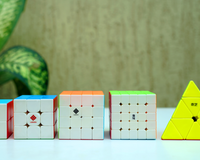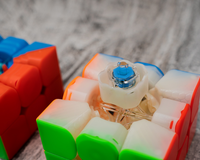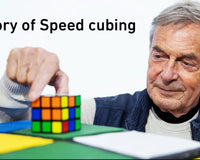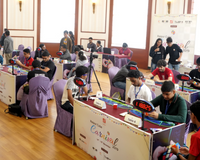General Idea
The general consensus that big cubes are tougher to improve at is quite flawed. The majority of people imagine big cubes to require immense algorithmic knowledge and learning a lot of new things. However, big cubes actually provide one of the best platforms for intuitive learning and improvement in a way like no other.
What Makes Big Cubes Different?
The key difference that separates big cubes from most other puzzles is the fact that the stages of solving big cubes need a lot more intuition, practice, and pattern recognition than other things. The more solves one does, the more they get acquainted with these aspects of the solve and the greater their appreciation for the same. In fact, just working on efficiency and intuition can get you very far in solving most puzzles.
How Do I Get Faster? - The Components
Mindset - Grinding is Crucial
To start with, you need to create the mindset needed to do a lot of solves. Naturally, our brains are wired to perform better with the repetition of an activity, which applies to big cubes in a revolutionary sense. By doing a lot of solves, you encounter cases that are either the same or can be set up into cases you already knew, which creates the connection in your brain to execute them at a rate faster than what you began with.
Take centers, for example. It is one of the aspects of the solve that contains the most varied types of cases, with bars, blocks, and all sorts of conceivable patterns. When you keep solving, whether timed or untimed, you subconsciously think of ways to solve each case, and your muscle memory takes over in terms of helping you to acquire control over the execution. By making this process conscious, you enable yourself to start seeing only the important blocks/bars and focus better on looking to the next case while performing the solution to the current one.
Drawing From The Experts
Next, you need to look at others (preferably people better than you) solving the puzzles, and take what you can from their solutions. By doing this, you can understand and implement more efficient solutions on your own solves. Then, by following the ideology of repeated solving, you solidify these solutions into your muscle memory, which helps shave time off your total solve time.
A good starting point is to analyze/watch top big cube solvers such as Max Park, Feliks Zemdegs, Kevin Hays, and Tymon Kolasinski, and understand exactly what goes through their minds when they solve. There are plenty of other big cube solvers that have either their own ways of improving solve efficiency or turning style, and you can discover them on YouTube.
Turning The Puzzle - Speed & Efficiency
This brings us to the next point. Turning style a.k.a. Turning efficiency or speed is a very important part of solving cubes that have so many layers. You need to be accurate while turning, and make sure not to overshoot or undershoot too much, to avoid things such as lockups, catches, and pops. In addition, you need to execute parts that are familiar to you with great speed, to avoid wasting any time on them and save time for the tougher parts such as looking ahead to your next pieces.
Learn from World Class Speedcubers
It can be noted that a lot of top cubers have extremely smooth turning styles, which is attributed to their accuracy in turning, regular practice, and focus while solving. It is important to develop these and learn from them, to speed up your improvement over a period of time. Grinding also helps with creating good habits, but be careful because it may contribute to cementing your bad habits at the same time, which can be detrimental to your time.
Self-Analysis
Finally, the most important part is self-analysis. If possible, record your solves and try to observe where your pauses are most prevalent. By doing so, you will know exactly where you need to improve and you can then proceed to work on exactly that part. Also, you can look at it in slow motion to analyze your exact solution to various cases and figure out if there are any areas that can be improved in terms of efficiency and/or speed.
Also, you can share these videos (only if you’re comfortable) with other cubers who are willing to help! This is an underrated thing to do and can bring so many benefits on your journey to big cube success. If you know any great big cube solvers, you can ask them if they’d be willing to help you out, and by taking their expert guidance and advice, you can implement things you never knew were lacking in your solves. As they say, experience is one of the best factors to contribute to teaching.
All This is Good, But How Do I Actually Do All These Things??
This could arguably be the most important and unanswered question, not just in this blog, but in the cubing forum in general. There is only one good answer and while it sounds very basic, embracing it is key. The answer is: you need to be having fun in order to see REAL improvement. 
It’s like with anything… By having fun, you increase your brain’s affinity to performing the activity, and make that process of improvement that much more fruitful! You might assume that you can’t learn to enjoy it, but that is extremely untrue. There are so many things to fall in love with, especially when it comes to big cubes.
Conclusion
The reduced algorithms, the intuitive cases, the ever-improving pattern recognition, the reduction to a 3x3, the variety in solutions, the effect of turning more efficiently, the feeling of breaking barriers that are much larger in minutes, the perks of analyzing your own solves and actually seeing exactly where to improve, and last but not the least, the “big cube effect”. The big cube effect isn’t a real scientifically proven phenomenon, but a lot of cubers claim that by solving say a 7x7 and practicing, they automatically see improvement in cubes such as the 5x5 and 6x6. This could be due to the fact that while the methods remain the same, the number of pieces to solve is lesser on lower-ordered cubes.
Regardless, what are you waiting for? Get yourself a 4x4, 5x5, 6x6, 7x7, or any other bigger cube, and get started on your journey! I promise you won’t regret it. Big cubes are the best.
About Author

Akshaansh Chilakapati
Akshaansh Chilakapati is a speedcuber from Hyderabad who specializes in big cubes. He started cubing when he was 15 and has 5 years of cubing experience. He loves to play sports, and music and has a passion for astrophysics. He has attended 20 competitions and won a total of 64 podiums with 16 gold medals. He is also ranked 13th in India for the overall Sum of Ranks (SOR).






























